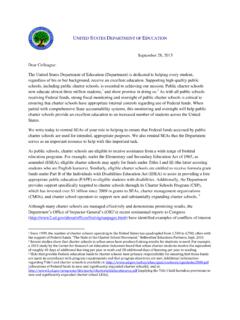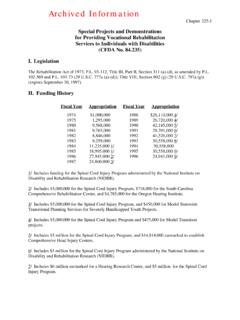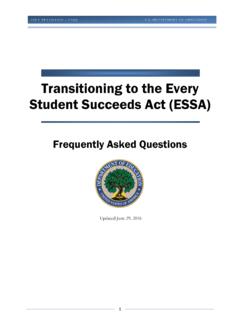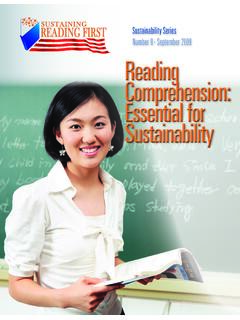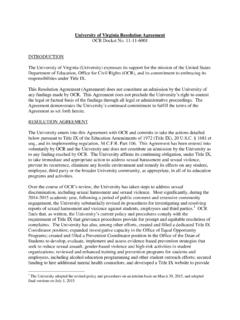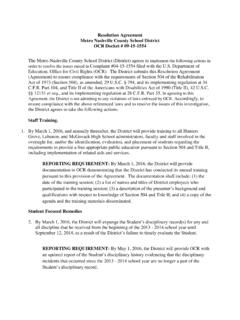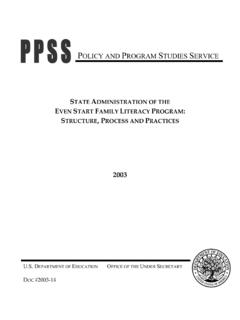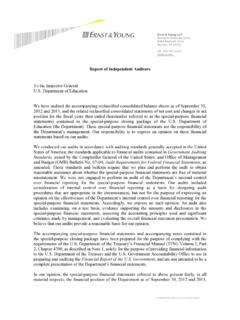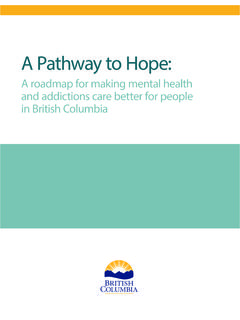Transcription of Strategies for Using American Rescue Plan Funding to ...
1 Strategies for Using American Rescue Plan Funding to Address the Impact of Lost Instructional Time2 Department of Education Dr. Miguel A. Cardona Secretary of Education August 2021 This report is in the public domain. Authorization to reproduce it in whole or in part is granted. While permission to reprint this publication is not necessary, the citation should be Department of Education: Strategies for Using American Rescue Plan Funding to Address the Impact of Lost Instructional Time, Washington, DC, 2021.
2 This report is available on the Department s website at Availability of Alternate Formats On request, this publication is available in alternate formats, such as Braille or large print. For more information, please contact the Department s Alternate Format Center at 202-260-0818 or via e-mail at Notice to Limited English Proficient Persons If you have difficulty understanding English, you may request language assistance services for Department information that is available to the public. These language assistance services are available free of charge.
3 If you need more information about interpretation or translation services, please call 1-800-USA-LEARN (1-800- 872-5327) (TTY: 1-800-877-8339), email us at write to Department of Education, Information Resource Center, 400 Maryland Ave., SW,Washington, DC Contents I. Introduction .. 4 II. Reengaging students by meeting their social, emotional, mental health, and academic needs .. 6 a. Building trust with families to support in-person learning .. 6 b. Supporting students during key transitions.
4 9 c. Using community partnerships to support reengagement .. 10 d. Addressing student social, emotional, and mental health needs .. 10 e. Reengaging and supporting students in their learning .. 12 f. Supporting students with disabilities .. 13 g. Elements of high-quality and effective tutoring .. 14 h. The role of school leaders .. 15 i. Creative approaches to staffing .. 16 III. Supporting parents and caregivers in their child s success .. 19 a. Engaging and communicating with parents and caregivers.
5 19 b. Expanding home visits .. 20 c. Sharing data and resources with families to support student learning .. 20 IV. Using high-quality assessments to support student 22 a. The role of diagnostic and formative assessments .. 22 b. The role of summative assessments .. 23 c. Performance-based assessments .. 24 d. Using assessments as part of understanding students social and emotional needs .. 25 e. Supporting educator assessment literacy and development .. 25 f. Department resources .. 26 4 the passage of the American Rescue Plan Act of 2021 (ARP Act), local educational agencies (LEAs) and schools have significant federal resources available which should be used to implement evidence-based1 and practitioner-informed Strategies to meet the needs of students related to COVID-19.
6 While the pandemic has impacted all communities, it has deepened pre-pandemic disparities in access and opportunities facing students of color, multilingual learners, students with disabilities, and lesbian, gay, bisexual, transgender, and queer (LGBTQ+) students, with significant impacts on their learning as described in the Department of Education s (Department s) Office for Civil Rights report Education in a Pandemic: The Disparate Impacts of COVID-19 on America s Students. Further, parents whose children received virtual only or combined instruction were more likely to report higher prevalence of risk on 11 of 17 indicators of child and parental well-being than were parents whose children received in-person ARP Elementary and Secondary School Emergency Relief (ARP ESSER)
7 Funds provide an opportunity to make investments that respond to the urgent needs of students in ways that address gaps in educational opportunity and build local capacity to sustain meaningful and effective teaching and learning. ARP ESSER funds can be used to support the design, implementation, evaluation, and use of data to inform continuous improvement of proven and promising Strategies and practices to address the impact of lost instructional time. Section 2001(e)(1) of the ARP Act requires LEAs to reserve at least 20 percent of their ARP ESSER funds, and section 2001(f)(1) requires that states likewise reserve at least 5 percent of their ARP ESSER funds to (1)address the academic impact of lost instructional time2 through the implementation of evidence-based interventions; (2) ensure that the interventions implemented respond to students social,emotional, mental health, and academic needs.
8 And (3) address the disproportionate impact of COVID-19 on students from low-income backgrounds, students of color, students with disabilities, multilinguallearners, migratory students, students experiencing homelessness, and children and youth in fostercare. While ESSER funds under the Coronavirus Aid, Relief, and Economic Security Act (ESSER I) and theCoronavirus Response and Relief Supplemental Appropriations Act (ESSER II) may also be used for all ofthe purposes for which ARP ESSER funds may be used, LEAs and SEAS are not required to set aside aspecific amount of ESSER I or ESSER II funds to address the academic impact of lost instructional Department s COVID-19 Handbook, Volume 2.
9 Roadmap to Reopening Safely and Meeting All Students Needs (Volume 2) includes Strategies for addressing the impact of COVID-19 on students, educators, staff, and families such as meeting students basic needs (including food security), creating safe and inclusive learning environments, accelerating students learning through instructional approaches, tutoring, and expanded learning time, increasing educational opportunity, and stabilizing 1 The ARP Act defines evidence-based as having the meaning in section 8101(21) of the Elementary and Secondary Education Act of 1965 (ESEA) (20 6311(b)(2)(B)(xi)) and includes several tiers of evidence.
10 Evidence-based, when used with respect to a state, LEA, or school activity, means an activity, strategy, or intervention that (1) demonstrates a statistically significant effect on improving student outcomes or other relevant outcomes based on strong evidence from at least one well-designed and well-implemented experimental study ( tier 1 ); moderate evidence from at least one well-designed and well-implemented quasi experimental study ( tier 2 ); or promising evidence from at least one well-designed and well-implemented correlational study with statistical controls for selection bias ( tier 3 ); or (2) demonstrates a rationale based on high-quality research findings or positive evaluation that such activity, strategy, or intervention is likely to improve student outcomes or other relevant outcomes and includes ongoing efforts to examine the effects of such activity, strategy, or intervention ( tier 4 ).
